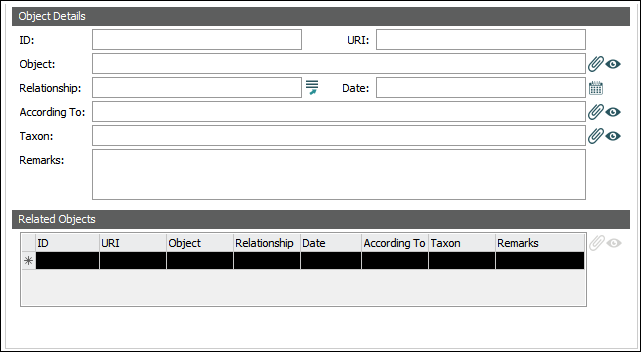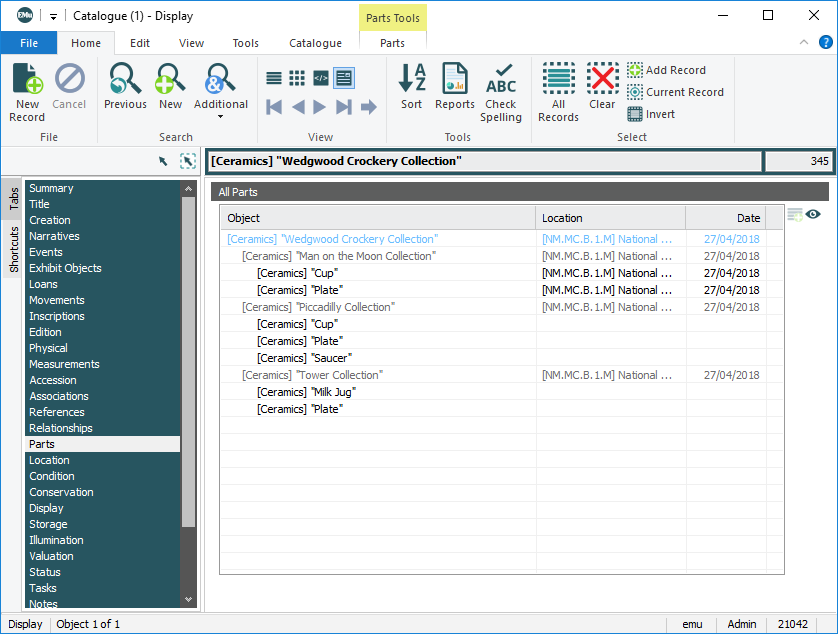EMu supports multi-discipline collections within the one Catalogue module. Examples of collection disciplines include:
Cultural Collections
- Ethnology
- Anthropology
- Archaeology
- Science and Technology
Art Collections
- Paintings
- Drawings
- Prints
- Sculptures and 3-Dimensional Objects
- Decorative Art
- Performing Arts
- Photography
- Textiles
- Digital Objects
Natural History Collections
- Invertebrate Zoology
- Vertebrate Zoology, with separate disciplines for the main vertebrate groups such as Mammalogy, Ornithology, Ichthyology, Herpetology and Amphibians
- Earth Sciences, including rocks, minerals, gems, meteorites
- Palaeobiology, including vertebrate and invertebrate Palaeontology and Palaeobotany
- Botany
- Horticulture
- Physical Anthropology
Special Collections
- Digital Assets
- Historical Society Collections
- Archives
The EMu Catalogue is customized to the specific needs of each museum: you determine which disciplines are relevant to your institution. Each discipline can have its own set of fields so that users working within a specific discipline see only the fields relevant to them (in other words, users cataloguing pottery do not see fish fields). EMu detects the discipline of an object you are working with, whether you are inserting, editing, searching for or viewing records, and automatically adjusts the screen to display only those fields relevant to that discipline.
However, as all records are contained within the one Catalogue module, EMu can be used to search across the entire collection (subject to your security profile).
As well as discipline specific fields, EMu provides a suite of general fields across all disciplines, such as object type, location, condition, and so forth, ensuring that the same management processes can be applied within each discipline. EMu can even support museum processes that cross discipline boundaries, for example multi-discipline loans.
A Natural History institution might comprise three departments / categories:
- History & Technology
- Humanities
- Natural Sciences
with each of these divided into disciplines (Scientific Groups) and sub-disciplines:

The hierarchical structure and naming scheme will differ from one institution to another, but the principle is the same: when an object is added to an institution's collection and recorded in the Catalogue, it is located somewhere in a Collection Identification hierarchy, e.g.:
- Category: (Collection Identification)
- Scientific Group: (Collection Identification)
- Discipline: (Collection Identification)
- Scientific Group: (Collection Identification)
Thus, if this Natural History museum were to acquire a piece of Serandite, it would record it in the Catalogue module as:
|
Collection Identification fields |
Catalogue hierarchy |
|---|---|
|
Category: |
Natural Sciences |
|
Scientific Group: |
Geology |
|
Discipline: |
Mineralogy |
As well as satisfying the purposes of classification, an advantage of locating an object within a hierarchy is that it is possible to limit a search to a specific discipline, reducing the number of records to be searched, and making for much faster searching.
Note: As every institution is able to customize EMu to suit its requirements, there are many different versions of EMu. Even where institutions have the same modules, the tabs included in each instance of the module may be different; and even where institutions have tabs with the same name, the fields on those tabs may be different. For that reason this section only provides a general description of modules.
| Tab | Description |
|---|---|
|
Summary |
Summary of accession, title and creation details for quick reference. |
|
Title |
Nature of the object, link to Accession Lots module, and various titles the object may have. |
|
Edition |
State, impression, publisher, watermark and notes. |
|
Creation (1) |
Name of the object's creator, where it was created and other creation details. |
|
Creation (2) |
Cultural origin of the object, subject classification, provenance and inscriptions. |
|
Physical |
Details of the object's medium and physical dimensions. |
|
References |
Links to Rights and Bibliography modules and lists image and filing references. |
|
Relationship |
Supports documentation of the Darwin Core Resource Relationship Extension: Note: The Relationship tab was introduced with EMu 6.4. Some modest customization of the Catalogue module by Axiell developers may be required to enable this tab. Please contact Axiell Support for details. |
|
Relationships |
Lists other objects that are related to the current object and their relationship. Used to record related objects and objects in a parent / child relationship. Here we specify whether an object is a parent or only a child object (an object can be both a parent and a child, or it might only be a child). If the object is a child object, we attach it to its parent object. Tip: See How to record parent / child objects for details. |
|
Parts |
Lists all related parent and child records in a hierarchical view. For example, this image shows the parent object Wedgwood Crockery Collection linked to three child objects, each recorded in a separate record:
Note: When the Parts tab is selected in the Tabs pane, the Ribbon will include a Parts tab with commands for working with parent / child relationships. Tip: See How to record parent / child objects for details. |
|
Location |
Used to record the location and changes of location of objects. Any change generates a record in the Internal Movements module. Lists a permanent location, a current location (and even a temporary location) if the object has been moved, who moved it, who authorized the move, and when. Includes a history of movements. Tip: See Locations module for more details. |
|
Condition |
Used to record details of the physical condition of an object. Any change generates a record in the Condition Checks module. Includes information about when and by whom the condition was last checked. Tip: See Condition Checks module for more details. |
|
Illumination |
Maximum lighting exposure for the collection item, as well as cumulative exposure so far. |
|
Display |
Records requirements for the correct physical environment in which to display the object. |
|
Storage |
Records requirements for the correct physical environment in which to store the collection item. |
|
Valuation |
Used to record the monetary amount for which an object is valued and its valuation history. Any change generates a record in the Valuations module. Links to a record in the Insurance module. Tip: See Valuations module and Insurance module for details. |
|
Events |
List of events associated with the collection item. Links to the Events module. Tip: See Events module for details. |
|
Loans |
List of loans associated with the collection item. Links to the Loans module. Tip: See Loans module for details. |
|
Movements |
List of movements associated with the collection item. Links to the Movements module. Tip: See Movements module for details. |
|
Conservation |
List of conservation strategies associated with the collection item. Links to the Conservation module. Tip: See Conservation module for details. |
|
Status |
Lists alteration and stocktake details. |
|
Tasks |
See Tasks tab for details. |
|
Notes |
See Notes tab for details. |
|
Multimedia |
See Multimedia tab for details. |
|
Security |
See Security tab for details. |
|
Audit |
See Audit tab for details. |
|
Admin |
See Admin tab for details. |



